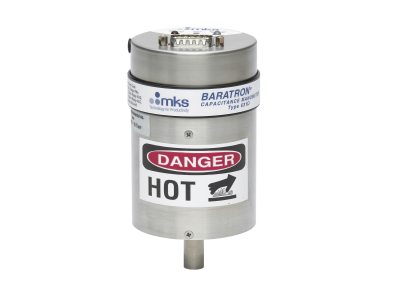Kapacitansmanometrar Absolut Tryck
631F 1-1000 TORR HEATED (150 OR 200°C) ABSOLUTE BARATRON® CAPACITANCE MANOMETER
The 631F 1-1000 Torr, Heated (150 or 200°C) Absolute Baratron® Capacitance Manometer, operating at very high internal temperatures, minimizes the deposition of process byproducts within the sensor by nearly eliminating output drift caused by contamination. Its available operating temperatures are 150°C or 200°C, permitting use in the most demanding vacuum processes in semiconductor manufacturing such as metal etching and nitride film chemical vapor deposition (CVD).
- 150°C or 200°C operating temperatures reduce contamination
- 0 to 10 VDC analog output proportional to absolute pressure
- Two optional pressure trip relays for controlling external equipment
- Inconel® sensor resists corrosion
- Performance is unaffected by pressure bursts
- Compact design & self-contained electronics save space
Baratron Capacitance Manometer Technology
Capacitance manometers are electro-mechanical gauges that can measure both pressure and vacuum. The capacitance gauge translates a pressure-modulated movement in a thin diaphragm into an electrical signal proportional to the pressure. The pressure sensor is the thin diaphragm that is exposed to the pressure or vacuum being measured via the inlet tube. An electrode is mounted in the reference cavity behind the diaphragm. Pressure differences between the process and the reference cavity deflect the diaphragm slightly, changing the distance between it and the electrode. Variations in this distance produce variations in the capacitance between the diaphragm and the electrode creating an electrical signal that is proportional to the pressure change. Since differences in the capacitance signal are produced by physical changes within the manometer and not by changes in the gas properties, pressure measurements by the capacitance manometer are independent of the composition of the gas being measured.
Percent of Reading Accuracy
Accuracy is specified as a percent of Reading, not Full Scale, as seen in some of the lower performance devices. Percent of Reading accuracy provides you with an even more accurate output signal in the lower scale of the pressure range, where it is needed most.
Internally Heated to 100°C
These capacitance manometers are temperature controlled to 100°C for improved accuracy. Unheated versions are exposed to ambient temperature variations which can degrade the sensor accuracy. These devices have the sensor enclosed in a volume that is maintained at a constant temperature above ambient. This solution improves the manometer’s accuracy and repeatability and lowers instrument drift by reducing or eliminating process contamination within the manometer. Heated manometers are recommended for applications that require maximum accuracy and repeatability, operate above ambient temperature and for those processes that employ hot gases.
Absolute Pressure Measurement
These Baratron® pressure transducers are referenced to vacuum for absolute pressure measurement. Applications include: vacuum furnaces, freeze-drying of fruits and vegetables, gas lasers, automotive component testing, bottle coatings, and vacuum distillation.
All-Inconel® Wetted Surfaces
These pressure transducers feature all Inconel® construction of the pressure sensor allowing it to operate without damage in virtually any chemical environment, including exposure to halogens, deionized water and steam, and ozone.
0 to 10 VDC Proportional Analog Output
These Baratron capacitance manometers feature a high-level 0-10 VDC analog output signal that is linear with pressure. This analog output can be interfaced with an MKS pressure controller, an MKS power supply/display instrument, or any instrument that meets these requirements.
Recommended for Etch Processes
MKS has implemented solutions within the manometer’s pressure sensing element to minimize the effects of process byproducts and process gases. For processes that generate large quantities of condensable byproducts, MKS recommends the etch baffle sensor that significantly reduces the ability of byproducts to reach the sensor, minimizing process-induced zero drift. For very low pressure processes where fluorine burn-in is the main issue, MKS recommends the fluorine friendly (FF) sensor offering the ultimate in short- and long-term stability in fluorine chemistry.


